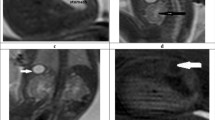Abstract
Objective
To assess the usefulness of antenatal ultrasound examinations for detecting fetal morphological abnormalities in the first and second trimesters.
Methods
A prospective cohort study was conducted at a single Japanese university hospital in the period from February 2011 to September 2013. Patients in whom ultrasound was attempted at both 11 to 13 + 6 and 18 to 20 + 6 weeks’ gestation and who were delivered at our hospital were enrolled. After delivery, neonatal congenital abnormalities were reviewed and compared with the ultrasound findings in the first and second trimesters.
Results
The subjects were 2028 singleton babies. Abnormal fetal morphological findings were found in the first trimester in 28 cases. In these patients, fetal anomalies detected as diagnostic findings were anencephaly (2 cases) and endocardial cushion defect (2 cases). Findings suggestive of fetal anomalies were observed in 24 cases in the first trimester. Twelve cases with ultrasound findings in the first trimester, including fetal edema, anencephaly, endocardial cushion defect, exhibited an abnormal chromosome after amniocentesis. Ultrasound findings in the first trimester disappeared until 18 weeks of gestation in eight cases, and they were preserved in three cases. Fetal anomalies were primarily noted in the second trimester in 10 cases. However, after delivery, morphological abnormalities were primarily observed in 18 cases.
Conclusion
Major congenital abnormalities were identified in the first trimester morphological assessment. We think the use of a combination of the first trimester ultrasound screening and the second trimester ultrasound scan for detecting fetal anomalies was effective.

Similar content being viewed by others
References
Chandrasekaran N, Viswanatha R, Bhide A. Ultrasound in antenatal diagnosis of structural abnormalities. Obstet Gynaecol Reprod Med. 2013;23:101–7.
Souka AP, Pilalis A, Kavalakis I, et al. Screening for major structural abnormalities at the 11- to 14-week ultrasound scan. Am J Obstet Gynecol. 2006;194:393–6.
Luchi C, Schifano M, Sacchini C, et al. Detailed fetal anatomy assessment in the first trimester at 11, 12 and 13 weeks of gestation. J Matern Fetal Neonatal Med. 2012;25:675–8.
Souka AP, Pilalis A, Kavalakis Y, et al. Assessment of fetal anatomy at the 11-14-week ultrasound examination. Ultrasound Obstet Gynecol. 2004;24:730–4.
Schwarzler P, Senat MV, Holden D, et al. Feasibility of the second-trimester fetal ultrasound examination in an unselected population at 18, 20 or 22 weeks of pregnancy: a randomized trial. Ultrasound Obstet Gynecol. 1999;14:92–7.
Chandrasekaran N, Viswanatha R, Bhide A. Ultrasound in antenatal diagnosis of structural abnormalities Obstetrics. Gynaecol Reprod Med. 2013;23:101–7.
Syngelaki A, Chelemen T, Dagklis T, et al. Challenges in the diagnosis of fetal non-chromosomal abnormalities at 11-13 weeks. Prenat Diagn. 2011;31:90–102.
Grande M, Arigita M, Borobio V, et al. First-trimester detection of structural abnormalities and the role of aneuploidy markers. Ultrasound Obstet Gynecol. 2012;39:157–63.
Pilalis A, Basagiannis C, Eleftheriades M, et al. Evaluation of a two-step ultrasound examination protocol for the detection of major fetal structural defects. J Matern Fetal Neonatal Med. 2012;25:1814–7.
Nielsen DE, Vejlstrup N, Jorgensen C, et al. Prenatal detection of congenital heart disease in a low risk population undergoing first and second trimester screening. Prenat Diagn. 2014;35:325–30.
Meizner I. The ‘tulip sign’: a sonographic clue for in utero diagnosis of severe hypospadias. Ultrasound Obstet Gynecol. 2002;19:317.
Bezuska L, Mussa S, Muthialu N. Chest wall reconstruction in Marfan syndrome following aortic root replacement. Asian Cardiovasc Thorac Ann. 2014;22:872–4.
Author information
Authors and Affiliations
Corresponding author
Ethics declarations
Conflict of interest
There are no financial or other relations that could lead to a conflict of interest.
Ethical consideration
All procedures followed were in accordance with the ethical standards of the responsible committee on human experimentation (institutional and national) and with the Helsinki Declaration of 1975, as revised in 2008 (5). Informed consent was obtained from all patients for being included in the study.
About this article
Cite this article
Takita, H., Hasegawa, J., Arakaki, T. et al. Usefulness of antenatal ultrasound fetal morphological assessments in the first and second trimester: a study at a single Japanese university hospital. J Med Ultrasonics 43, 57–62 (2016). https://doi.org/10.1007/s10396-015-0653-1
Received:
Accepted:
Published:
Issue Date:
DOI: https://doi.org/10.1007/s10396-015-0653-1




